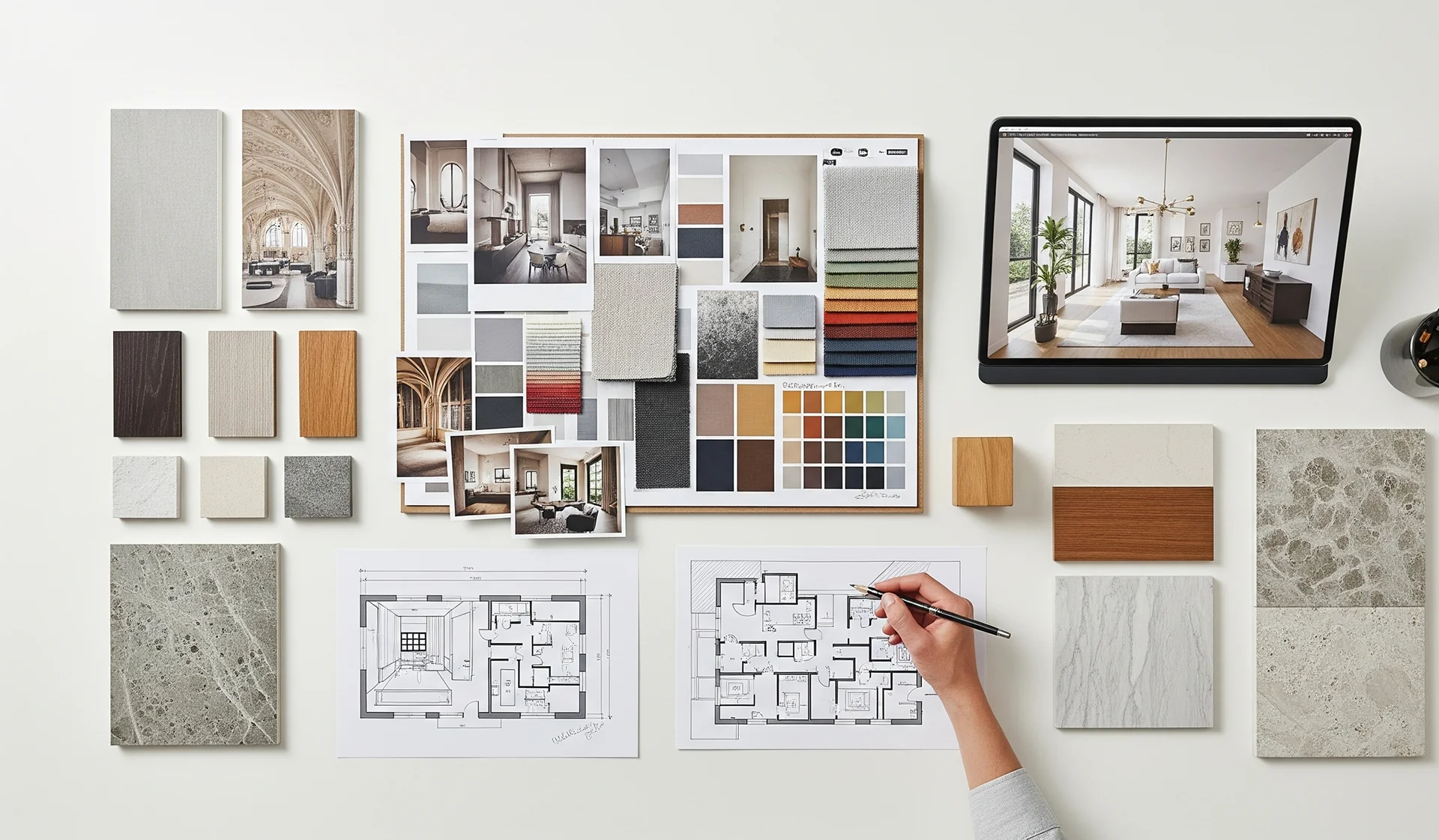Brainstorming Process, Conceptualisation, and Creating Interior Design Ideas
Creating a beautiful and functional space requires a thoughtful brainstorming process. Whether you’re designing a cozy home or a productive office, the initial stages of interior design ideas are crucial.
A well-planned interior design concept can transform any space into a haven that reflects your personality and meets your needs. In this article, we’ll explore the key elements of the brainstorming process and how it contributes to effective interior decorating ideas.
The Fundamentals of Interior Design Creativity
Interior design creativity is not just about aesthetics; it’s a complex interplay of psychology, functionality, and innovation. Effective interior design ideas and concepts require a deep understanding of how people interact with their environments, making design thinking a crucial element in the creative process.
Design Thinking in Interior Spaces
Design thinking is a human-centered approach to innovation that involves empathy, creativity, and experimentation. In interior design, this means understanding the needs and behaviors of the people who will be using the space. By applying design thinking principles, designers can create spaces that are not only beautiful but also functional and user-friendly.
For instance, a well-designed office space can boost productivity and employee satisfaction by incorporating elements such as natural light, comfortable seating areas, and collaborative workspaces. This approach to design is rooted in empathy and a deep understanding of human behavior.

The Psychology Behind Effective Design Concepts
The psychology of design plays a significant role in creating effective interior design concepts. Understanding how different colors, textures, and layouts affect human emotions and behaviors is crucial.
For example, certain colors can stimulate or calm the mind, while specific textures can add warmth or coolness to a space.
“The way we design our environments can significantly impact our well-being and productivity.”
By combining design thinking with an understanding of the psychology of design, interior designers can create spaces that are both aesthetically pleasing and functional. This holistic approach to design is what sets PC interior designers apart.
The Complete Interior Design Process: A Step-by-Step Guide
The interior design process involves several key steps that guide designers from conceptualization to completion. This comprehensive process ensures that the final design meets your needs and expectations.
From Interior Concept to Completion: The Design Journey
The design journey begins with understanding your requirements and preferences. It then progresses through various stages, including:
- Initial consultation to understand the project’s scope and objectives
- Design development, where concepts are created and refined
- Implementation, where the design plan is executed
Effective communication is crucial throughout this process to ensure that the design stays on track and meets your expectations.
Key Milestones in Professional Design Projects
In professional design projects, several key milestones mark the progress of the design process. These include:
- Completing the design concept and presenting it to the you
- Finalizing the design plan and obtaining you approval
- Procurement and installation of design elements
By understanding and following these milestones, designers can ensure a smooth design journey and successful project outcome.
Effective Brainstorming Techniques for Interior Design
Effective brainstorming techniques are essential for interior designers to generate innovative and functional design concepts. Brainstorming allows designers to explore a wide range of ideas, from spatial layouts to color schemes, ultimately leading to a well-rounded design plan.
Mind Mapping for Spatial Concepts
Mind mapping is a powerful tool for interior designers, enabling them to visually organize ideas and create a cohesive design narrative. By starting with a central idea, designers can branch out to related concepts, such as furniture selection, lighting, and texture, creating a comprehensive map of their design.
Benefits of Mind Mapping:
- Enhances creativity by visually connecting ideas
- Facilitates organization and prioritization of design elements
- Encourages collaboration among design teams
Mood Boards and Visual Ideation
Mood boards are another effective brainstorming technique, allowing designers to visually represent their ideas through images, colors, and textures. This technique is invaluable for communicating design intent to you and stakeholders.
Digital vs. Physical Mood Boards
The choice between digital and physical mood boards depends on the designer’s preference and the project’s requirements. Digital mood boards offer flexibility and ease of sharing, while physical mood boards provide a tactile experience, allowing for a more intimate connection with the design elements.
Ultimately, the most effective brainstorming technique will depend on the individual designer’s workflow and the specific needs of the project. By combining techniques such as mind mapping and mood boards, designers can unlock their full creative potential and produce outstanding interior design solutions.
Conceptualization: Transforming Ideas into Design Plans
Conceptualization is the bridge between creativity and practicality in interior design projects. It’s the phase where abstract ideas begin to take concrete form, guided by the principles of effective design.
Sketching and Preliminary Visualizations
The process of sketching and creating preliminary visualizations is fundamental to conceptualization. It allows designers to explore different aspects of their ideas, from spatial arrangements to aesthetic elements.
- Freehand sketching helps in quickly capturing initial ideas.
- Digital tools can refine these sketches, adding precision and detail.
- Preliminary visualizations aid in communicating the design intent to you and stakeholders.
Space Planning Fundamentals
Space planning is a critical component of conceptualization, focusing on the efficient use of space to meet the needs of occupants.
Key considerations include:
- Understanding the purpose and functionality required in the space.
- Analyzing the physical constraints and opportunities of the area.
- Creating a layout that balances aesthetics with usability.
Developing a Cohesive Design Narrative
A cohesive design narrative ties together the various elements of a design, creating a unified and meaningful whole.
This involves:
- Selecting a color palette and materials that reflect the design’s theme.
- Integrating furniture and decor that support the narrative.
- Ensuring that every design decision contributes to the overall story.
By focusing on these aspects, designers can transform their ideas into comprehensive design plans that are both beautiful and functional.
